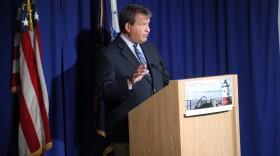In a terminal at the Westchester County Airport in White Plains Wednesday, County Executive George Latimer announced upgrades to noise monitors and stormwater treatment. Surrounding communities have complained about noise from flight paths and the airport for years. The county has been addressing PFAS contamination as well.
Hoping to quell noise without dampening business, County Executive Latimer says the upgrading of all the permanent airport noise monitors has been completed and integrated with the complaint handling system. These fixed noise monitors are in addition to the portable noise monitors that had been added based on the origin of the majority of noise complaints.
“The county airport, as a neighbor to the people who live in Harrison, in Rye Brook, in North Castle, in White Plains, and for those under the flight path that comes here, that also includes places like Chappaqua and Armonk and Pleasantville and so forth, that this was a large neighbor and could be, at times, an intrusive neighbor,” Latimer says.
One year ago, the county and Federal Aviation Administration held an open house to discuss airport noise and air traffic procedures, as well as a noise study conducted by a consultant for the county. Latimer says finding solutions to challenges at the airport was a pledge he made upon taking office in 2018.
“The noise monitoring equipment that was here when we walked in the door was not adequate to properly track the noise, and, if you don’t track the noise, you can’t make a case to the Federal Aviation Administration about air flights, traffic, traffic patterns, and so forth,” Latimer says. “And then we also wanted to make sure that the system of reporting complaints was up to date so that if a person is frustrated and they lodge in a complaint, that the complaint is properly lodged and the system can be tracked, and then we can look at what we have to do to take care of that.”
Latimer on Wednesday also announced the Board of Legislators has authorized his request for a $3.75 million bond act to complete remediation measures at an outfall as part of the county’s Storm Drain Replacement project at the airport.
“And this is important because it’s also, it’s mandated by the New York state Department of Environmental Conservation and it’s also part of the strategy that we have to protect the groundwater that comes out of this airport because we have a drinking watershed to our north and we have the Blind Brook that leads down to the Long Island Sound that goes to our south, and both of those bodies of water are important and fragile bodies of water that we want to make sure to protect,” says Latimer.
The airport boundary is about half a mile from the drinking water supply — the Kensico Reservoir, the source of most of the county’s drinking water. And before the Air National Guard left the airport in 1983, the Guard conducted firefighting training using foam that contained PFAS, which contaminated the groundwater at the airport, groundwater that is not used for drinking. In 2019, Latimer signed an executive order aimed at safeguarding the public from PFAS chemicals. In an effort to prevent the kind of drinking water contamination that has occurred in Newburgh and elsewhere in the state and country, he mandated groundwater testing at least twice a year for PFAS, or per- and polyfluoroalkyl substances. The airport is in County Legislator Nancy Barr’s district.
“So, it’s become a priority to make sure that the drinking water that’s found in the reservoirs near the airport is free of these chemicals and to make sure it stays that way. To date, there are, the levels are undetectable in the reservoir, and we, we, again, we, we want to make sure it stays that way,” Barr says. “And so this, this bond is to, to fortify the storm drains that carry the water from, from the airport to the reservoirs and, and to make sure that any of those chemicals that are in the groundwater do not end up being carried into the reservoir when it rains.”
She says the money comes from the airport fund. Harrison Supervisor/Mayor Ron Belmont says he appreciates the measures being put into place and says airport upgrades positively affect businesses nearby.
“We’ve been doing a renaissance on Westchester Avenue. The past few years we had Lifetime Fitness, Wegmans, national companies come into Westchester Avenue,” Belmont says. “This airport is a vital hub. It also helped us rejuvenate Westchester Avenue.”
He hopes for the rebirth of what was once called “Platinum Mile.” Latimer also addressed air quality.
“The county has completed an air emissions inventory and, if you compare where we are today to 2007 base numbers, we have significant reduction in air emissions because we have reduced the total number of flights combined with airport improvements,” says Latimer.
Latimer says he was scheduled to meet with Sierra Club reps Thursday to discuss possibly advancing solar and green technology at the airport. The Democrat also talked about an airport master plan supplement, a process halted by the COVID-19 pandemic. Latimer says the process should engage the community in person, and will resume it when safe to do so. The last master plan for the airport was in 1989.
Meantime, Westchester County Airport received just north of $4 million in the latest federal COVID-19 relief package. New York Stewart International received more than $2.3 million, and other airports in the Hudson Valley, in Dutchess, Orange and Sullivan Counties, each received $13,000.








